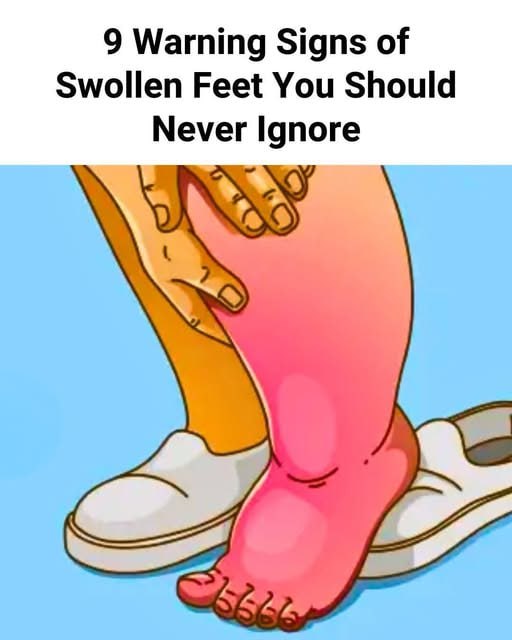
Swollen feet may seem like a minor issue, especially after a long day of walking or standing—but sometimes, that puffiness could be a sign that something more serious is going on. While occasional swelling might be harmless, chronic or severe cases shouldn’t be ignored.
Your feet are the foundation of your body, and when they swell, they’re often trying to tell you something important about your overall health. Let’s break down 10 common causes of swollen feet and when it’s time to talk to your doctor.
1. Standing or Sitting for Too Long
If you’ve been on your feet all day or sitting still for hours (like during a long flight or desk job), gravity causes fluids to collect in your lower extremities. This is a temporary condition and usually resolves with rest, elevation, and movement. Stretching your legs and taking short walks can help.
2. Injury or Trauma
Spraining your ankle or injuring your foot can lead to immediate swelling. This is your body’s natural reaction to protect the affected area. The swelling might be accompanied by bruising, pain, or limited movement. Applying ice and elevating your foot can help, but if the pain persists or worsens, medical attention is necessary.
3. Pregnancy
Swollen feet are extremely common during pregnancy, especially in the third trimester. Hormonal changes and increased pressure on the veins slow blood flow, causing fluid to accumulate in the feet and ankles. While mild swelling is expected, sudden or severe swelling could be a sign of preeclampsia—a potentially dangerous condition—and should be evaluated by a healthcare provider.
4. Medication Side Effects
Certain medications can cause water retention, leading to swollen feet. These include:
-
Blood pressure medications (like calcium channel blockers)
-
Nonsteroidal anti-inflammatory drugs (NSAIDs)
-
Steroids
-
Antidepressants
-
Hormone therapies (estrogen or testosterone)
If you notice new swelling after starting a medication, don’t stop taking it—consult your doctor first.
5. Venous Insufficiency
This occurs when the valves in your leg veins are weakened or damaged, making it hard for blood to return to the heart. As a result, blood pools in the lower legs, causing swelling, especially by the end of the day. This condition can lead to complications if untreated, such as varicose veins or skin ulcers.
6. Heart Disease
Heart failure can cause fluid to build up in the body, especially in the lower extremities. If your heart isn’t pumping blood efficiently, your body retains sodium and water, leading to noticeable swelling in your feet, ankles, and sometimes your legs. Swelling from heart failure may be accompanied by shortness of breath or fatigue and requires immediate medical evaluation.
7. Kidney Disease
Your kidneys are responsible for filtering excess fluid and waste from the body. When they’re not functioning properly, fluid can accumulate—especially in the feet, ankles, and hands. Kidney-related swelling often occurs with symptoms like frequent urination, fatigue, or foamy urine. This should not be ignored.
8. Liver Disease
The liver helps regulate the production of proteins that affect blood volume and fluid balance. Liver diseases, such as cirrhosis, can lead to low levels of albumin—a protein that helps keep fluid in your bloodstream. Without enough albumin, fluid leaks into surrounding tissues, including the feet. Swelling from liver issues is usually accompanied by other symptoms like jaundice or abdominal swelling.
9. Infection
If your foot or toe becomes red, warm, and swollen—especially if you have diabetes or poor circulation—it could be a sign of an infection. Diabetics are particularly vulnerable to foot infections due to decreased sensation and slower wound healing. Prompt treatment is critical to avoid serious complications.
10. Lymphedema
Lymphedema happens when your lymphatic system is blocked or damaged, often due to cancer treatment, infection, or injury. This blockage prevents lymph fluid from draining properly, causing swelling—usually in one leg or foot. The swelling may feel tight or heavy and should be assessed by a medical professional.
When to See a Doctor
While occasional, mild swelling can be normal, you should contact a healthcare provider if:
-
Swelling comes on suddenly
-
It only affects one foot or leg
-
It’s accompanied by pain, redness, heat, or shortness of breath
-
You have a history of heart, kidney, or liver disease
-
There are signs of infection (fever, open sores, pus)
-
The swelling persists or worsens over time
Don’t wait for things to get worse. Chronic or severe swelling could indicate an underlying health condition that needs treatment.
Final Thoughts: Don’t Ignore the Signs
Swollen feet can range from harmless to hazardous depending on the cause. Paying attention to your body’s signals—and knowing when to act—can help you catch potentially serious issues early.
Next time your feet swell up, don’t just chalk it up to a long day. Ask yourself: Is this normal—or is it something more?
And remember, when in doubt, it’s always best to get checked out. Your feet carry you through life—make sure you’re caring for them in return.





